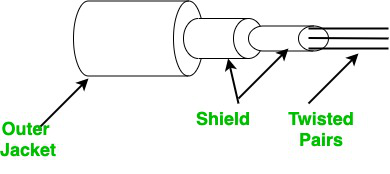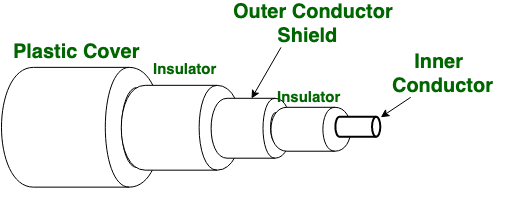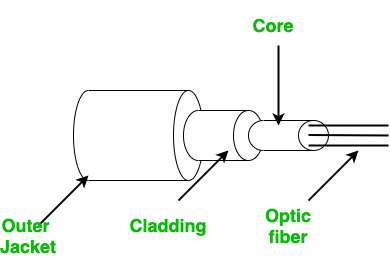Twisted pair cable
As the name suggests these are two twisted pairs of cables or wires made up of insulated copper. These are twisted together in such a way that they run parallelly one wire is used for the transmission of data and the other wire is used for ground. Usually, these wires or cables are 1mm in diameter. The twisted-pair cable is made up of 2 copper wires (insulated) arranged in a spiral pattern. Noise interference is more often the problem in these cables but it can be handled by increasing the number of turns per foot of twisted pair cable.
Working of twisted-pair cables: The twisted pair cable has an outer jacket that keeps the wires together, shield for protection of cable, and color-coded plastic insulation to uniquely identify each conductor, and twisting of wires to cancel the electromagnetic waves that create noise interferences during the transmission of data. When current flows through the cable then a small circular magnetic field is created around the wire. For the connection between two devices connectors are needed at both ends like RJ45 for computer connection.

Types of Twisted pair cables are:-
- Unshielded Twisted pair (UTP)
- Shielded Twisted pair (STP)
Unshielded Twisted pair (UTP)
UTP cables are the most common twisted pair cables that are used in computer networks as well as in telecommunication. These cables are made up of 4 color-coded copper wires twisted together to cancel the disturbances from outer sources and the electromagnetic interference. There are different categories of UTP cables used for telecommunication and other purposes. For example, some are used for telephone line services with good speed and some offer 4mbps to 16mbps speed some provide 20mbps speed and it is enough for communication for longer distances.
Connectors: The most common UTP connector is RJ45 (Here, RJ stands for registered jack), (There are two types RJ45 male and RJ45 female cable). RJ45 is a keyed connector, which means that the connector can be connected in only one way. Its cables are mostly used on an ethernet connection. For example, Computers, Modems, Printers, and various network storage devices.
Merits
- These cables are cheaper.
- The maintenance cost is low.
- It doesn’t require any ground wire.
Demerits
- The transmission rate of data is slow.
- Noise is high in these cables.
Shielded Twisted pair cables (STP)
In comparison with UTP’s Shielded twisted pair cables are costlier and consist of metal foil sometimes made up of insulated conductors. Metal foils help to improve the quality of the wire which otherwise will be affected by noise. These cables are used to reduce crosstalk and the interference caused due to electromagnetic waves. The company that first introduced these STP cables was IBM. These cables are used for both Analog and digital transmissions.
Merits
- The transmission rate of data is fast.
- Noise is slow in these cables.
Demerits
- These cables are costlier.
- The maintenance cost is higher.
- It requires ground wire.
Applications
Some applications of Twisted pair cables:
- Telephone systems: To provide voice and data channels.
- LANs use twisted-pair cables.
- The DSL lines used by the telephone companies also use the unshielded twisted pair cables to provide extremely high data rate connections.
Co-axial cable
The most common type of transmission media that is used in various applications like tv wires and ethernet connection setup also. This is a form of transmission media that consists of two conductors kept in parallel to each other. It has a central core conductor of a solid copper wire enclosed in an insulating sheet and the middle core conductor is made up of copper mesh and lastly an outer metallic wrap that helps in noise cancellation. The whole cable is covered and protected by a plastic cover.
It is considered better than twisted-pair cables because of the higher frequency range. Coaxial cables are best suited for shorter distances as there are higher chances of data loss in more distances for that fibre optic cables are best as fibers are capable of higher data transfer and with greater speed as compared to coaxial cables. Cost and maintenance are also less, unlike fiber optic cables. And durability these cables are more.
The various types of coaxial cables:
- Triaxial Coaxial Cable
- RG-49Coaxial Cable
- RG-11 Coaxial Cable
- RG-6Coaxial Cable
- Hardline cable
- Rigid Coaxial Cable
- Semi-Rigid Coaxial Cable
- Formable Coaxial Cable
- Flexible Coaxial Cable
Working of Coaxial Cables: Coaxial cables are made up of copper wires for carrying the higher frequency signals this wire is covered with an insulated foil cover whenever current flows it maintains a constant distance between the conductor and the next layer and then a shielded wire that prevents the interference of noise in between the transmission and at last the plastic cover that protects the whole cable from any outer disturbances. Hence, a coaxial cable carries a signal in a way that when the current enters the centre copper wire as well as the metal shield. The metal conductors at that point generate a magnetic field. The insulators help the signals not to come in contact with each other, they also the signal from outside magnetic fields. In this way, the signal is carried over larger distances without much loss.

Coaxial Cable Standards: These cables are categorized by their radio government (RG) ratings and each RG number denotes a unique set of physical specifications. Example,
RG-59 75 ohm Cable TV
RG-58 50 ohm Thin Ethernet
Application
Some applications of Coaxial cables:
- Digital telephone networks
- Analog telephone networks
- Cable TV networks
- Ethernet LANs
Merits
- The cost of coaxial cables is less as compared to fibre optic cables.
- It has a higher data transmission rate.
- It can be used in both analog and digital transmissions.
- Higher frequency applications can use coaxial cables for better performance.
Demerits
- For long distances, the cost of these cables will be higher.
- The size of these cables is usually bulky because of various layers of metal as well as copper and plastic.
- The data transmission in long distances is poor.
Fiber-optic cables
Also known as optic fiber cables are highly efficient and advanced data transmission cables that allow the transfer of data in a very large volume. Fiber optic cables allow data transmission with the help of electrical signals. These are thin pipes made up of glass or plastic known as optic fibers and data or information flows via light in these cables. With higher bandwidth and high-quality performance optic fiber cables are best suited for long-distance data transfer and communication.
Types of Fibre-Optic Cables;
- Single-mode Fibres: It is capable of one way transmission with a rate of almost 50 times more than multimode fibres. Used in small scale companies and in local area networks also.
- Multimode Fibres: It has higher bandwidth and cable of two-way transmission capable of higher data transmission. Used in local area networks, corporate sectors and private networks also.
Working of fiber-optic cable: Fiber optic cables carry information via light so at the transmitting side the light source is first encoded with data or information and then the data starts flowing in the core of the fiber optic cable in a complete bouncing manner with a complete internal reflection then there is cladding that helps the light to remain inside the cable after reaching the receiver side the data is then decoded like the original. So basically fiber optic is a form of transmission media for the transfer of data via light with higher bandwidth and a higher rate of transmission.
It consists of five major parts named as: core, Cladding, Coating, Strengthening, and Outer jacket.
Here, Core is a thin part of the glass of the optic fibre cable and cladding is the insulation around the core and coating is the protective layer for optical fibre and the strengthening part allows protection to the core and at last outer jacket for the whole optic fibre tube.

Application
Some applications of Fibre-optic cables.
- One of the most popular and important uses of Fibre -optic cables is the INTERNET.
- Television broadcasting These cables are very much suitable for transmitting signals for high-definition televisions because of their greater bandwidth and speed.
- Surgical operations in medical these cables are used in various fields of medicine and research purposes as their cost is low as compared to other cables.
- It is used in industries and in defence services also these cables are of great use.
Merits
- Long durability: These have long durability of almost 100 years.
- Low cost: Due to the cheaper cost these cables are in high demand usually of more use.
- Greater bandwidth and speed: Higher speed and great bandwidth help in faster and even smoother data transmission.
- Light signals: In the same fiber cable light signals of one fiber and the other do not interfere with each other which is not in the case of other cables.
Demerits
- Delicacy: Fibre-optic cables are more delicate as compared with copper wires. If bent too much these cables can be damaged easily.
- Installation Cost: The installation process is cost-effective as it requires machines and specialists team for the setup of the fiber cables.
- Low power: Since data flows via light in these cables power supply is limited, and for high power emitters cost would be more.
0 Comments:
Post a Comment